
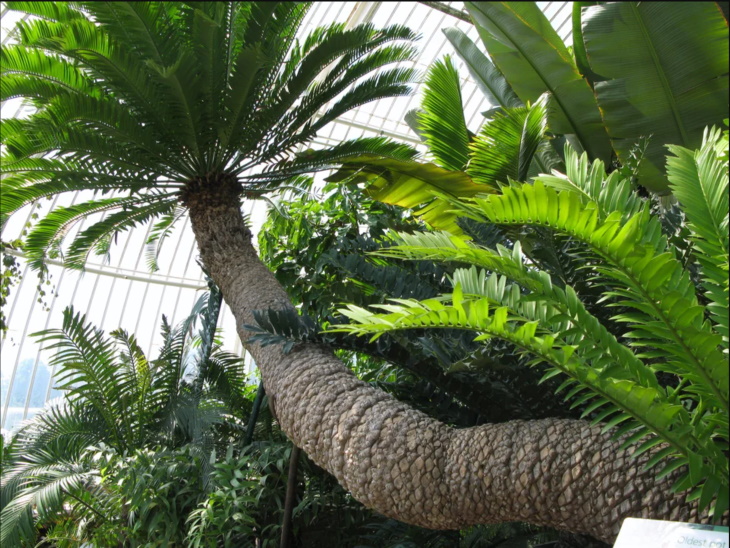
Cycads are ancient trees that predate any other type of living seed plant. These remarkable trees have lived alongside dinosaurs, and they resemble palms and ferns in appearance, adding a tropical appearance to your home.
The superpower of these trees is that they grow very slowly, which saves the plant a lot of energy and allows you to enjoy its appearance without repotting for years. In fact, the longest-living potted plant in the world is a cycad. Pictured above, this record-breaking plant is called the Eastern Cape Giant Cycad (Encephalartos altensteinii), and it’s lived at the UK Kew Gardens for nearly 250 years.
By far the most widespread cycad in the home is the Sago Palm. Native to Japan, this plant is often grown in bright spaces indoors or outdoors in warmer climates. If you care for your Sago Palm well, avoid overwatering it, and provide it with enough sun, it will easily live for decades. Just one word of caution - keep this plant out of reach of kids and pets because it’s extremely toxic.
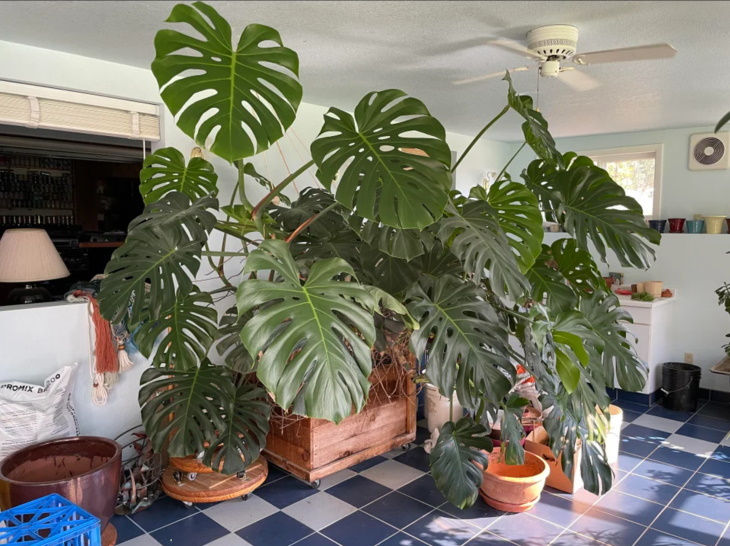
Monstera Deliciosa is one of the most beautiful plants out there. The large fenestrated leaves of this huge vining plant make it a popular choice for indoor growers. And it's crazy easy to grow too! Monsteras happily embrace a variety of climates and don’t mind drying out in-between watering. The low-maintenance nature of this plant is probably why they can easily live indoors for decades. The monstera in the image above, for example, is over 40 years old.
Do keep in mind, however, that monsteras are fast-growing plants. They will expand by 28 inches (71 cm) in size every year, so make sure you have plenty of space in the room that will serve as its home. Over time, the fenestration (holes and slits in the leaves) will grow too, rendering the plant even more beautiful. As the previous feature on this list, though, monsteras are toxic to pets and humans, so don’t touch the leaves and stems of the plant without gloves to avoid skin irritation.
Is the classic Swiss Cheese Monstera too big for your home? The so-called Mini Monstera (Rhaphidophora tetrasperma) and Monstera Adansonii are two great long-living alternatives for smaller spaces. They’re just as agreeable and look similar to the classic monstera while also being more compact.
Related article: 14 Common Plants That Are Toxic for Your Pets

The ZZ plant is another extremely popular and resilient species. It will thrive indoors for decades, requiring very little of your attention. In the image above, you can see a very interesting variety of the ZZ plant called the ZZ Raven for its black leaves. When they first appear, the leaves are green, but they darken as they mature.
The waxy leaves and thick branches of this houseplant point to its exceptional ability to retain water. Native to Central Africa, the ZZ plant has evolved thick bulbous roots that hold water well. What's more, this potted plant doesn't even require that much sunlight, so just put it wherever you see fit, and if you see a darkening of the leaves, move it to a place with more sunlight for some. Expect to repot your ZZ plant every 1-2 years.
That said, do keep the plant away from kids and pets, and of course, handle it carefully yourself, as the ZZ plant contains toxic calcium oxalates.

Never heard of Rhipsalis? This is an entire genus of flowering jungle cacti. Most species in this fascinating genus are native to the jungles of Central America, the Caribbean, and northern South America, and they grow by attaching themselves to trees.
You’ve surely met at least one of these guys in your life - the Christmas cactus (Schlumbergera). This flat-leaved cactus has long stems that bloom gorgeous pink, white, or red in the middle of winter.
The beauty of these plants is their diversity of stem shapes and flowers. These jungle cacti are also much easier to grow indoors than traditional desert cacti and succulents because they can easily tolerate moderate and low-light conditions. These plants live in optimal conditions for at least a decade and up to a century.
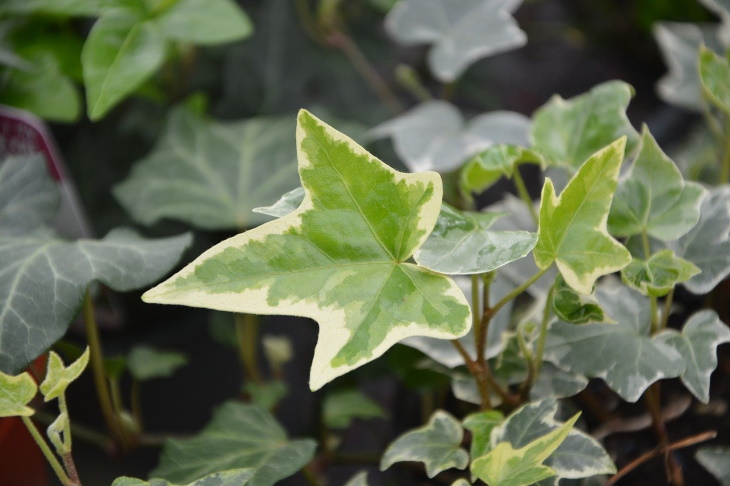
Native to Europe and western Asia, ivy is an elegant classic. The trailing plant has long vines richly decorated with small maple-like leaves. English ivy is well-known for being both long-living and fast-growing. These plants can grow up to 9 feet (2.7 m) in one year, covering entire walls in green foliage, and they can survive indoors for over a century.
Ivy thrives in shade and doesn’t need much care at all. Water the plant when the soil dries out, and you’re good to go. You may also be happy to learn that ivy is one of the best air purifying plants: its ability to clean air by absorbing carbon dioxide is superior to other indoor plants. Keep this plant away from kids and plants, for its leaves contain poisonous components.
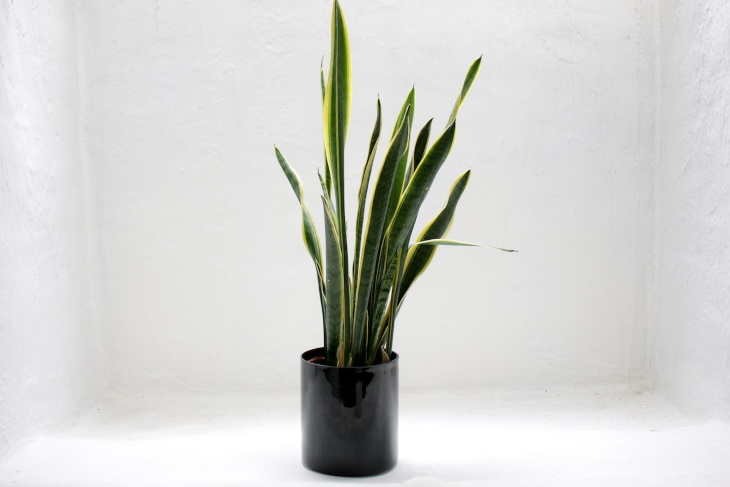
No other plant lends itself as beautifully to a minimalistic environment as the snake plant. And there are so many of them too! From the classic variety in the photo above to the Cylindrical Snake Plant that looks like thick hard spikes to the elegant and compact Bird’s Nest Snake Plant. These forgiving plants don’t require much water and only need a drink when the soil is completely dry. Despite being succulents, snake plants can tolerate shade.
Snake plants grow very slowly but steadily. In a low-light setting, a snake plant will live for 5-10 years. However, if you provide this plant with more light, it can easily live to be past 20 years old.
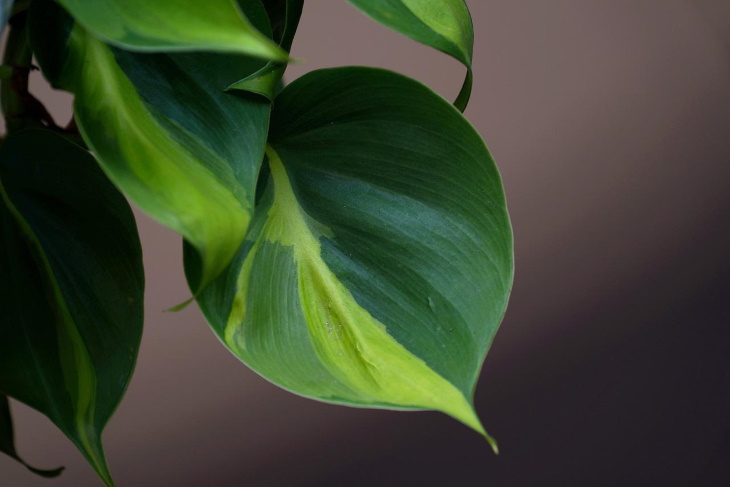
With nearly 500 existing species of philodendron, you’re spoiled for choice! This massive genus contains some of our favorite houseplants, such as the famous heartleaf philodendron (Philodendron hederaceum). This is a trailing plant with palm-sized heart-shaped leaves that come in many colors - from dark green to velvety brown to neon green.
If you’re going after that cascading waterfall of leaves look on your shelf, this plant will definitely give it to you. What’s more, these plants thrive in a variety of lighting conditions, including low light, so they’re a universal favorite among lazy plant lovers. There’s no need to water this plant too often either - wait for the top of the soil to dry out completely, and only then add more water.
A single philodendron can easily survive for over a decade. But even if your older philodendron grows to be a bit too leggy, you can take cuttings from it and propagate the same plant into several baby plants. This way, you’ll have a never-ending supply of philodendron after buying a single plant of your own.
Related article: Plant Propagation 101 - Easy Ways to Multiply Any Plant
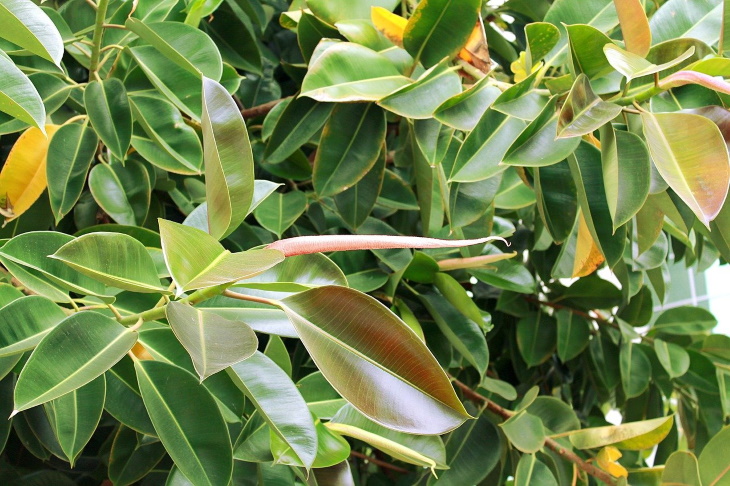
Ficus comes in many shapes and sizes. While the daintier, smaller varieties like the Creeping Fig (Ficus pumila) will not likely survive past the 25-year mark, others can live for decades and centuries. Ficus trees, such as the Rubber Fig (Ficus elastica) or the Fiddle Leaf Fig (Ficus lyrata) can grow mature and massive, for example.
If you have plenty of space and access to indirect bright light to give a tree, the Fiddle Leaf Fig is a trendy choice to consider. Indoor spaces with moderate to low light are not a good fit for these plants. Instead, get a Rubber Fig. These trees have large glossy leaves, and they come in pink-and-green, green-and-white, purple, dark green, and even black varieties.
Ficus trees that are happy in their current location will grow 24 inches (60 cm) or more each growing season, so you'll need to repot it once a year for the first few years. When the plant reaches the maximum size in your home, you can prune it back. Rubber plants can cause irritation and digestive issues in pets when ingested.
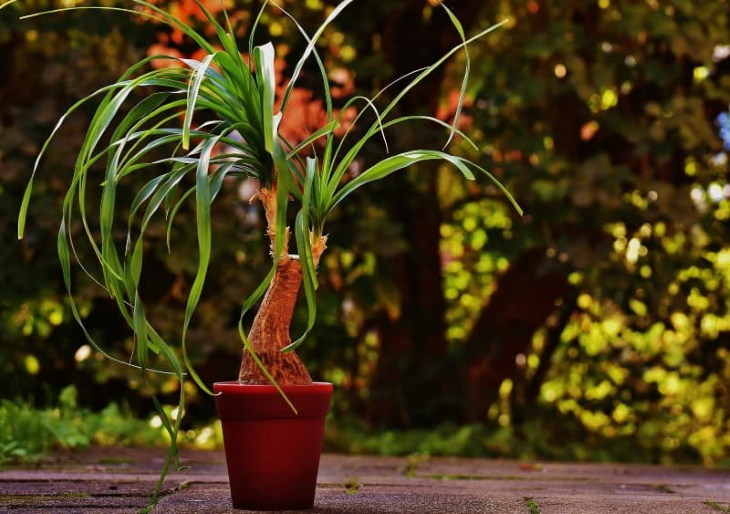
The Ponytail Palm has a thick stem and cute long thin leaves that start curling like locks of hair as the plant grows. How cute! In optimal conditions, these palms can live for several decades; they have been known to live past 100 years.
A favorite of people who travel a lot, the Ponytail Palm, also known as Elephant's Foot, doesn't need watering more than once every few weeks and enjoys a bit of drought. The plant is resilient to dry conditions because the trunk of the palm is rich in sap that holds water very well.
If the ends of the palm's leaves become brown, it means the plant is getting too much water. Technically speaking, ponytail palms require bright sunlight, but because these plants are so forgiving, semi-bright light will do just as well. Finally, these plants are also one of the few palm trees safe for pets!

Collecting cacti is pretty fun because they come in so many interesting shapes, textures, and colors! Since most cacti are slow-growing and small when you purchase them, you can grow many of them at once too.
Generally speaking, cacti live between 10-100 years. Of course, it all depends on the conditions in your home and the care the plant receives. For example, if you live in a temperate climate and cannot provide your cactus with bright light, it can die very rapidly. This is because cacti generally have a very dainty and shallow root system that will rot away even if you’re watering the plant very sparingly all winter.
Some cactus species that tend to grow well indoors are Angel Wings Cactus (Opuntia albispina), Rat Tail Cactus (Aporocactus flagelliformis), African Milk Tree (Euphorbia trigona), and Barrel Cactus (Ferocactus).
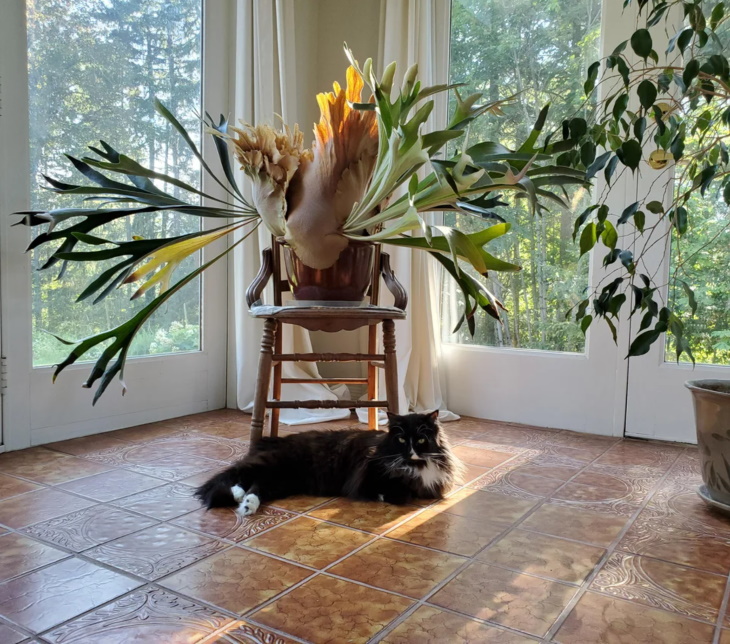
Staghorn ferns are a rather small but fascinating genus of epiphytic ferns, meaning that they grow on the trunk of trees. There are only 18 species of these plants, most of which are native to Africa, Australia, and Southeast Asia. Also known as Elkhorn ferns, the fronds of Platycerium ferns resemble the antlers of deer or elk. Indoors, these plants can live for decades and decades.
Staghorn ferns grow very slowly, but they can reach massive sizes. The most commonly grown Staghorn species is probably the Platycerium bifurcatum, which is pictured above (cat for scale). This species fares best in temperatures above 40°F, so you can probably bring it outdoors during the summer, but you’ll need to bring it indoors unless you live in a very mild climate (hardiness zone 9 and above). Staghorn ferns require bright but indirect light, as direct sunlight can burn their sensitive fronds. Despite being a type of fern, these plants do NOT require much water - watering them once a week will do.
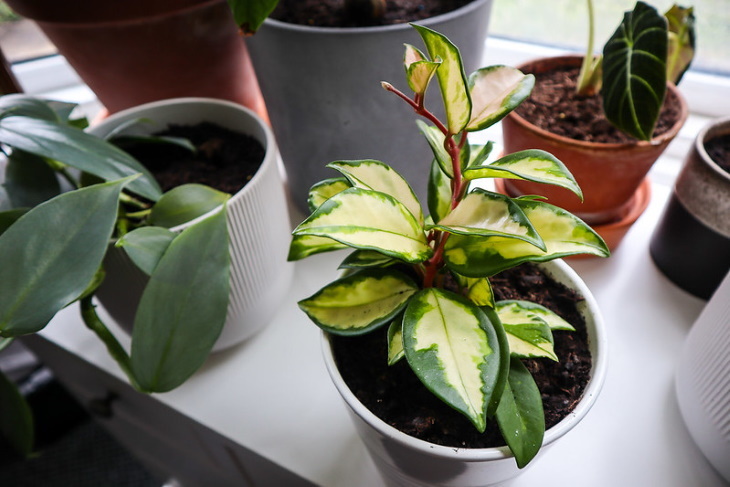
Last but definitely not least, let’s not forget to mention the magnificent Hoyas. These tropical plants are very popular these days, likely because they are easy to propagate and relatively low-maintenance. They grow very slowly and have fleshy, waxy leaves and beautiful colorful blooms.
Hoyas grow best in bright indirect light and moderate watering. Under optimal conditions, your hoya will survive for at least 5 years, but some more resilient species have been known to live for over three decades.
Speaking of resilient plants, the Wax Plant (Hoya carnosa) is believed to be the easiest hoya to grow. This vining plant originally came from Eastern Asia and Australia, and it only becomes better as it grows. Although there are several subtypes of Hoya Canosa, all of them have waxy foliage and attractive sweet-smelling flowers.
H/T: Houseplants Corner, Plantlovefest.com, Happy Sprout, Bestindoorsplant.com